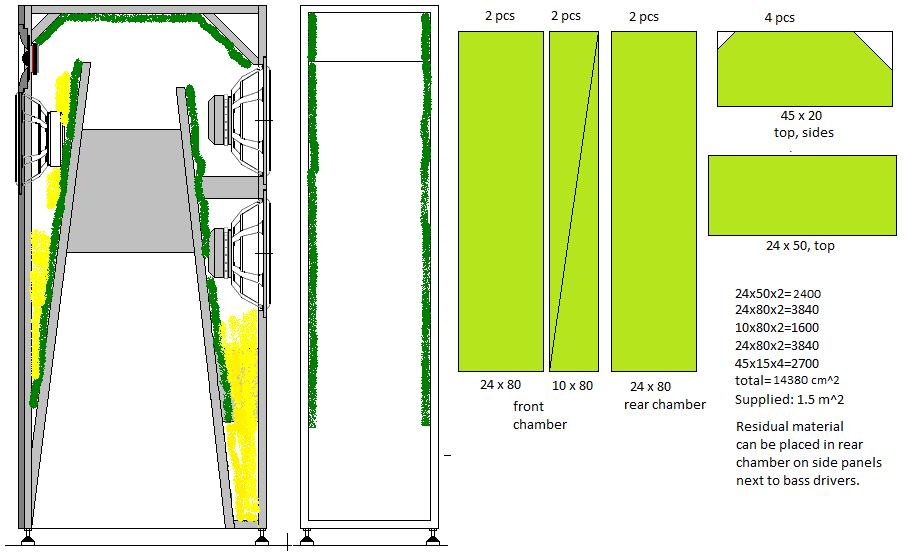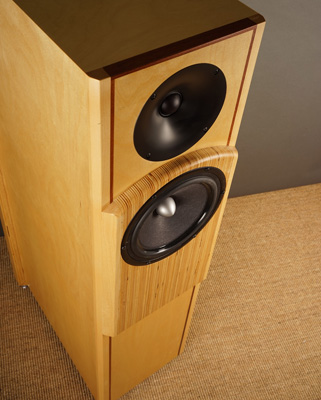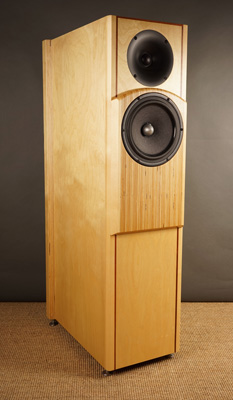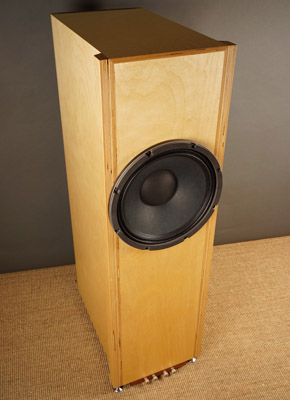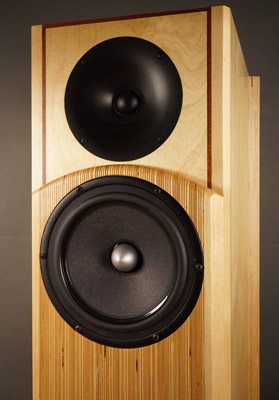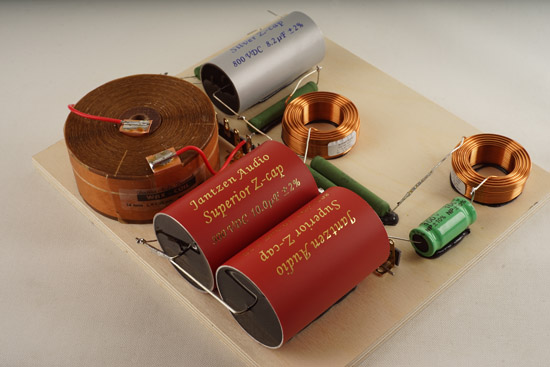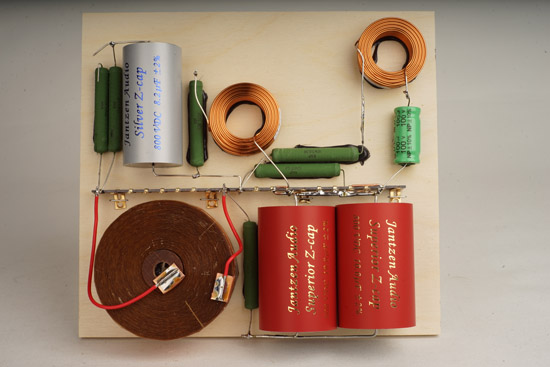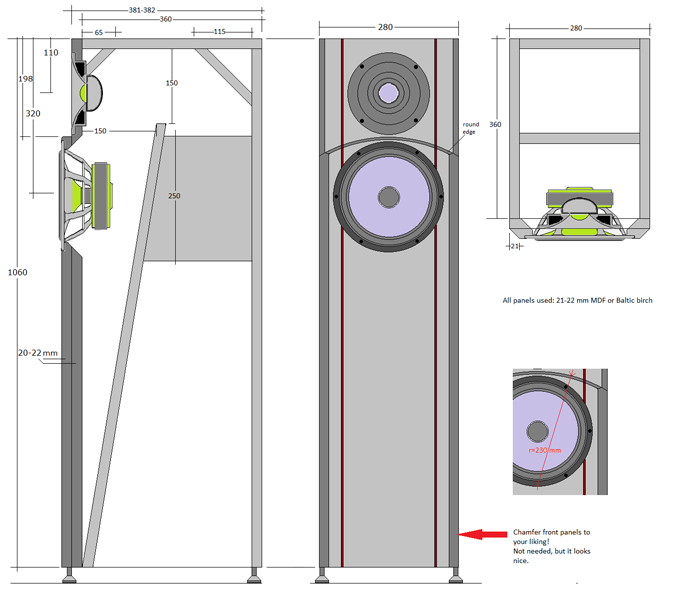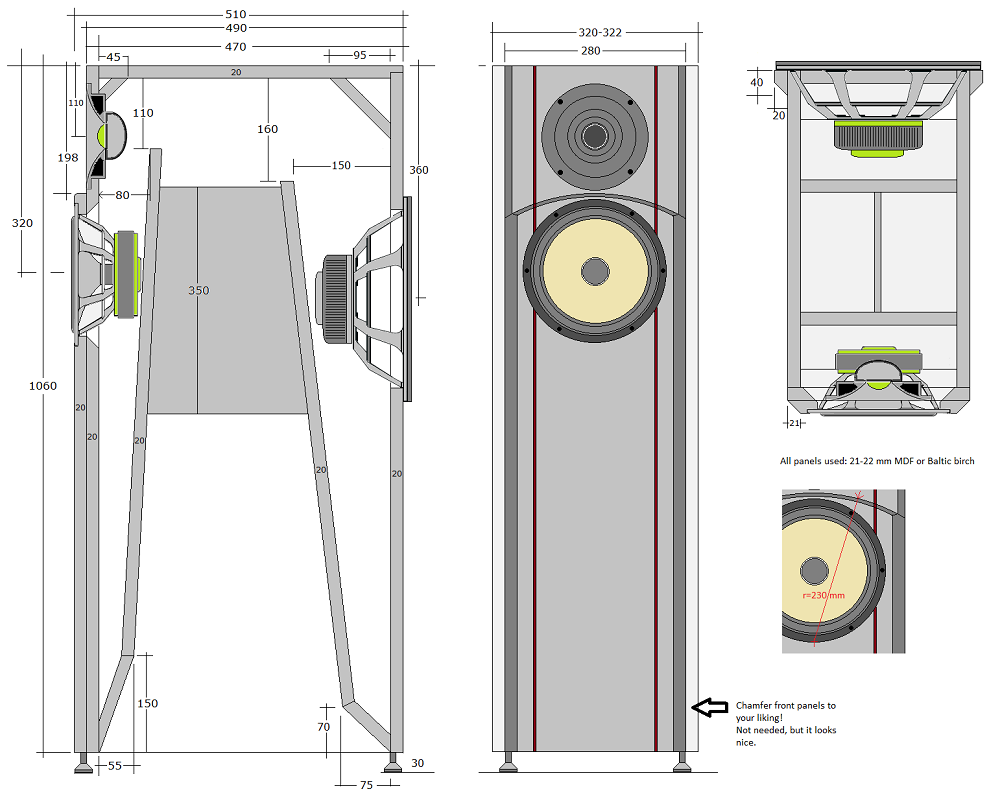DIY Loudspeakers: HOME INDEX UPDATES RESPONSE WHAT'S NEW
TQWT-mkIII
and
DTQWT-mkIII
Copyright 2022 © Troels Gravesen
GO TO:
DRIVERS CROSSOVER-TQWT CROSSOVER-DTQWT
CABINET-TQWT CABINET-DTQWT TQWT-KIT DTQWT-KIT MEASUREMENTS
TQWT/DTQWT mkIII FLAT
(upgrade kit for old cabinets with flat front
panel)

It's been six years since I had the first
production samples of the
JA8008 driver and
quite a range of speakers have been made around this high-efficiency
driver:
TQWT
(pdf file),
DTQWT-mkII,
DTQWT-212,
QUATTRO,
8008-CORNER,
8008-CENTER,
OBL-11,
OBL-15 plus quite a few never published.
There are two main features of the new TQWT-mkIII and DTQWT-mkIII constructions: New JA8008 HMQ driver and stepped baffle allowing a true LR2 filter to be implemented. The JA8008-HMQ driver features a high mechanical Q (low damping) and a better match to the magnificent Eminence bass driver(s), thus enhanced transient response and low-level detail. The stepped baffle allows true LR2 filter, which has become my favorite from the constructions made over the last few years. To properly implement LR2 filters we need to acoustically align the drivers, thus the stepped baffles.
This is - like the mkI and mkII - a speaker I can listen to for hours and hours. Not having a high-pass filter to the midrange pays off and the waveguide and crossover makes a seamless integration of mids and highs. How the bass will respond to your room is out of my control. Based on response from the numerous builders of mkI and -II, I guess 90% are happy, 5% have too much bass and 5% too little. Too much is always due to near-corner placement and the 5% too little had expected more or their room simply suck up bass energy. For those requiring more bass, add a 12-15" bass driver driven by a plate amp. Put it against the wall to get the necessary room gain and you should be able to tune things into place.
Questions are already coming in a few days after launch: Should I upgrade to mkIII. The answer is: If you're happy with mkI/mkII, don't. I try to implement new things when it makes a difference, but whether this will make you a happier person, I can't tell. So please do not ask!
To my ears the LR2 filter delivers enhanced transparency and micro
detail and at the same time protects the tweeter properly compared to
1st order filters. The large domes available for these
constructions have no trouble in terms of power handling with the target
2 kHz point of crossover.
The DTQWT-mkIII now features as standard a single 12" Eminence DeltaLite mkII
driver as most people, based on feedback, do not use flea-powered tube
amps, rather solid state - or higher powered
push-pull valve amps not
having any trouble running a minimum 4 Ohms impedance. Those wanting a higher
impedance (6 Ohms) can obviously still use two 10" bass drivers coupled in series
as was standard the DTQWT mkII. Go to
DTQWT mkII page for cabinet
details and bass section crossover.
The 12" Eminence DeltaLite 2512 delivers deeper bass compared to DTQWT
mkII - a bit surprising as the horn is basically the same length.
Together with the high-Qm JA8008 HMQ the bass performance is
significantly more dynamic compared to mkII. It now has the speed and
punch quality I have become addicted to from my ATS4 speakers.
Read about the new JA8008-HMQ
driver here
Read the story behind the JA8008 driver and TQWT construction
Read the story
behind the DTQWT and the special cabinet design
Useful links (Please follow all links before e-mailing!):
http://www.troelsgravesen.dk/tips.htm
http://www.troelsgravesen.dk/tips.htm#CONSTRUCTION_OF_CROSSOVERS
http://www.troelsgravesen.dk/crossovers.htm
http://www.troelsgravesen.dk/LCR-RC.htm
http://www.troelsgravesen.dk/Inverted-Polarity.htm
http://www.troelsgravesen.dk/choices.htm
http://www.troelsgravesen.dk/power-handling.htm
Like the TQWT and DTQWT mkII versions, these new
speakers will play any kind of music. The mkIII version is in no way a discriminative
speaker leaving out certain recordings as is often the case when
speakers excel in particular aspects of music reproduction. The "thing"
about these speakers is having a single driver handling
all of the midrange with no crossover between the bass and midrange. In
this respect the TQWT and DTQWT can play a few tricks any other of the
larger 3-4-ways systems on these pages cannot. Regardless of how smooth
a transition we can manage between bass and mid and regardless of how
good crossover components we use, the absence of a crossover between
bass and mid can be appreciated. The JA8008-HMQ driver is in fact the
same size as the 23I52 driver used in the ATS4 for upper bass and does
deliver the same punch and dynamic qualities as the 23I52.
We cannot tell other people what a speaker sounds like and regardless of how much
we could
write about the sound, it would never tell you what it's like, as little
as I can tell you the taste of a vintage wine or French goat cheese. If
you haven't tasted French goat cheese - and they come in many varieties
- it doesn't matter how much reviewers write. You have to taste it
yourself to know.
What you can do is read the many reports from TQWT and DTQWT
builders
here. Regardless of preference for rock, jazz or classical music,
these speakers have found an audience and maybe you will like it too. One thing
is for sure: These mkIII are better than the mkI and mkII versions. More
detail, better dynamics.
The new driver is JA8008-HMQ and the new main
speaker constructions are TQWT-mkIII and DTQWT-mkIII
as the modified crossover versions
of both were called mkII.
Standard tweeter is now the SEAS T35C002.
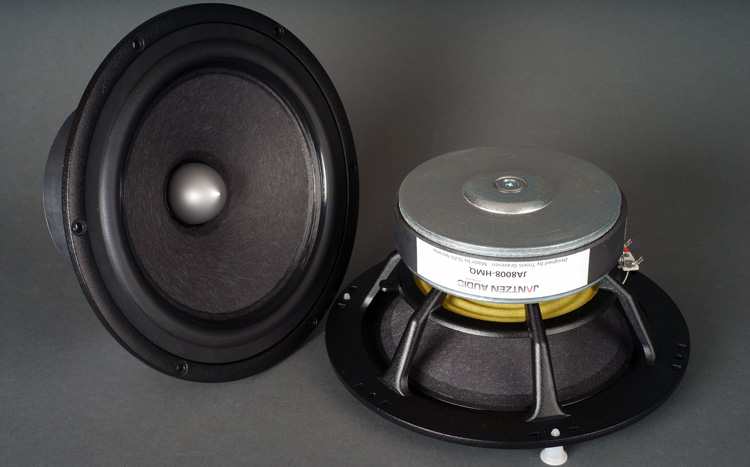
Above the JA8008-HMQ
Click image to view large.
A special coating ring between the cone and foamed rubber surround
smooth the 800-1000 Hz frequency range.
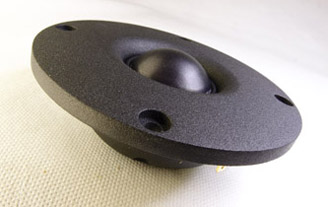
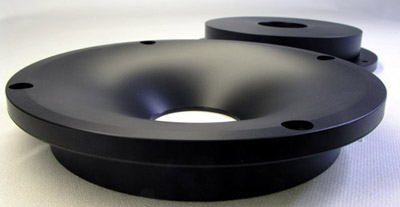
Click images to view large.
SEAS T35C002 tweeter and Jantzen Audio waveguide.
The waveguides are machined from solid non-resonant POM plastic, not
some cheap cast PBS plastic.
There are tolerances on the flange of the waveguide, 7-8 mm, so don't
route for this until you have it at hand!
Former Audax TW034 version has been discontinued.
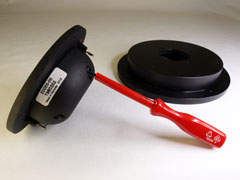
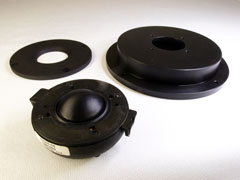
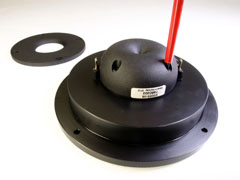
Mounting the T35 waveguide. Use the SEAS screws from the standard face
plate.
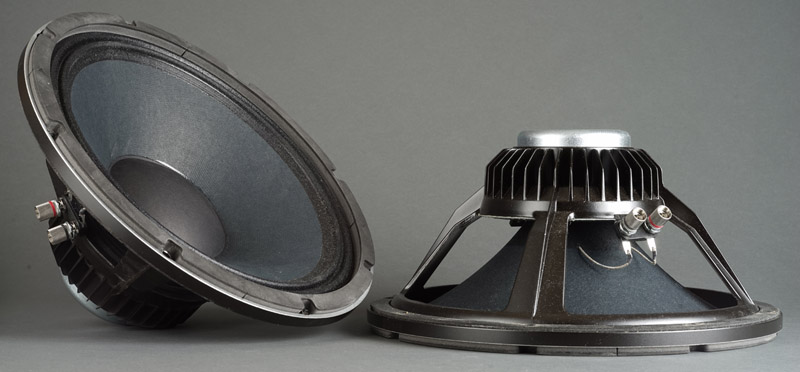
Eminence Deltalite II 2512 bass drivers
Click image to view large.
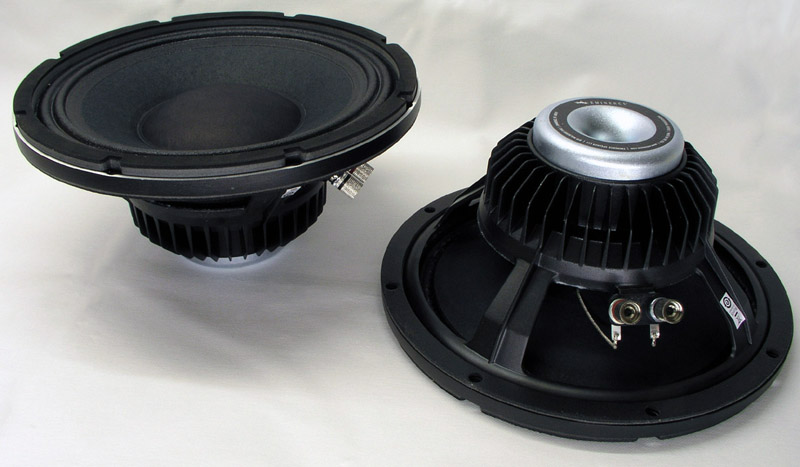
Eminence Deltalite II 2510.
Click image to view large.
PA drivers are often pretty rigid out of the box and I always do some "break-in" by pushing and pulling the membranes to their limit before mounting. On a fresh unit you can hear the lacquer on the spider cracking when doing so. This will do the same as at least 50 hours off burn-in. Take care and do no puncture the membrane with your fingers when doing so. In addition to this - and if you have a test CD with some 40-50 Hz sine waves - give the bass drivers a couple of hours at +/- 6-8 mm membrane excursion. All this helps loosen the suspensions and reach optimum performance quickly.
DeltaLite II 2510 specs
here.
DeltaLite II 2512 specs
here.
Get Deltalites here:
Europe:
12" bass drivers:
http://www.thomann.de/gb/eminence_deltalite_ii_2512.htm
10" bass drivers:
http://www.thomann.de/gb/eminence_deltalite_ii_2510.htm
UK:
12":
http://www.lean-business.co.uk/eshop/eminence-deltalite-ii-2512-neo-8ohm-12-250watt-speaker-p-850.html
10":
http://www.lean-business.co.uk/eshop/4-x-bundle-eminence-deltalite-ii-2510-neo-8ohm-10-250watt-p-1136.html
USA:
http://www.music123.com/accessories/eminence-deltalite-ii-2510-replacement-pa-speaker,
or
http://www.usspeaker.com/homepage.htm
Crossover
TQWT mkIII
BACK TO INDEX
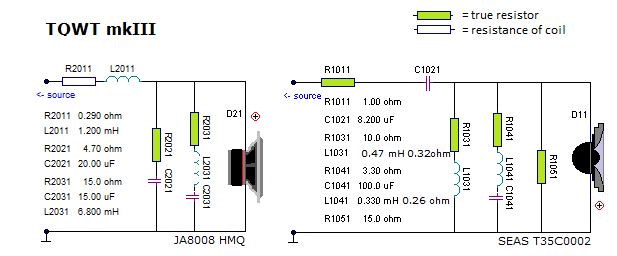
Please read below at DTQWT, same crossover except for no bass section.
Crossover
DTQWT mkIII
BACK TO
INDEX
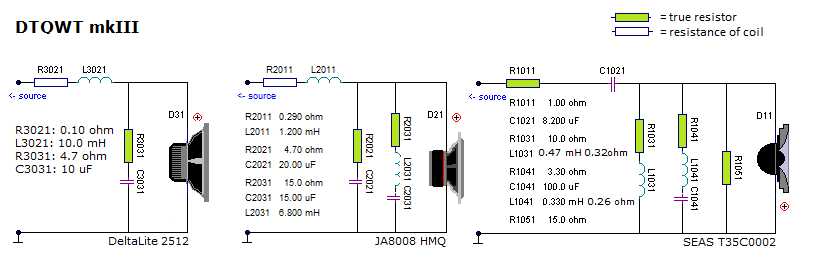
The bass section runs 1st order and due to the
single 8 Ohms driver we here have a 10 mH coil rather than the 18 mH
needed for two 8 Ohms drivers in series from the mkII version. The
"thing" about this speaker - and the mkI and mkII versions - is that the
middriver does not have a high-pass filter. Thus an 8" driver that can
handle the bass range as well as midrange. This has indisputable
benefits and is to be heard, even compared to my ATS-4. But every
speaker is a compromise.
The mid tweeter section features LR2 topology and due to the time
alignment we here have to invert tweeter polarity. 8008 section is as
simple as can be and the tweeter section takes use of a rather unusual
RL circuit with a 10 ohms series resistor. The LCR circuit flattens the
impedance peak and helps shaping the tweeter roll-off, which is as close
the target LR2 as can be. C1041 is a 100 uF electrolytic cap and believe
me, it doesn't sound better with a 100 uF PP in this place. It was
tried. If you cannot stand the sight of electrolytic caps, order a 100
uF PP. C1021 needs to be as good as can be, thus JA Superior-Z or
Silver-Z. They differ by their termination, copper for one, silver for
the other.
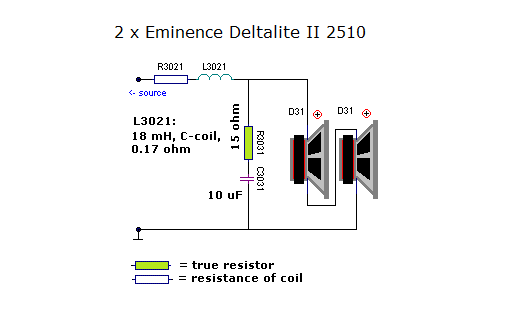
Should you want to maintain higher impedance (SET
amps) and a slimmer design, you simply replace the bass crossover with
the same as for the
DTQWT mkII and buy four Eminence DeltaLite II 2510 bass drivers and
adjust the rear panel like the mkII.
The 2 x 10" is included in the kit presentation
below.
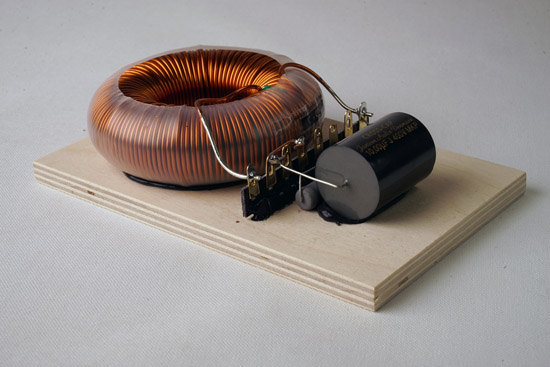
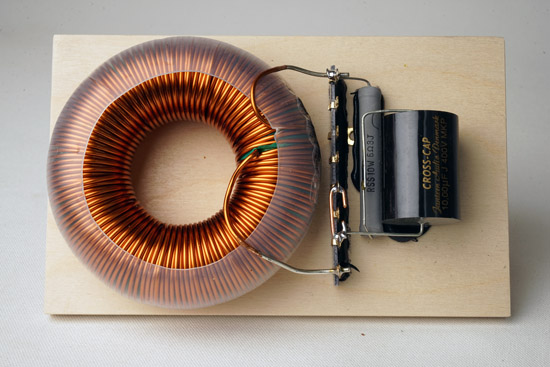
Bass section crossover.
Click images to view large.
The RC circuit
flattens the impedance rise towards higher frequences and allows the
coil to form a 1st order roll of.
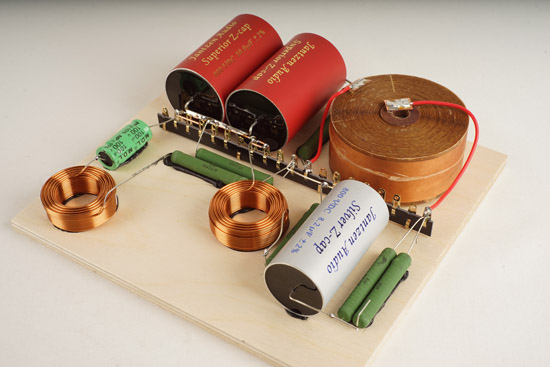
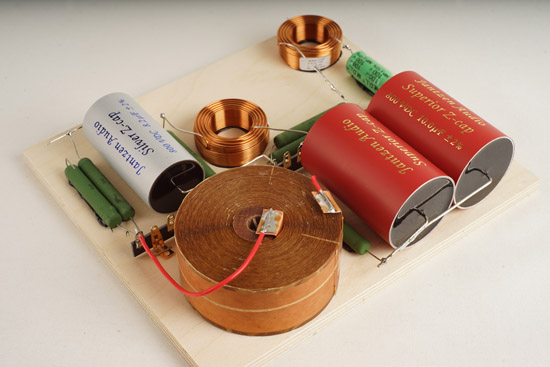
Mid-tweeter section crossover. Click images to view large.
Images here before the equalising circuit was added. See layout below.
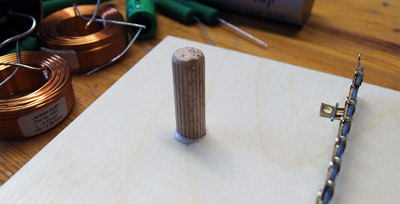
Wax coils are rather heavy and I use a dowel to secure the coil.
The coil is added a ring of Superfix, view
here for more
details.
CROSSOVER LAYOUT
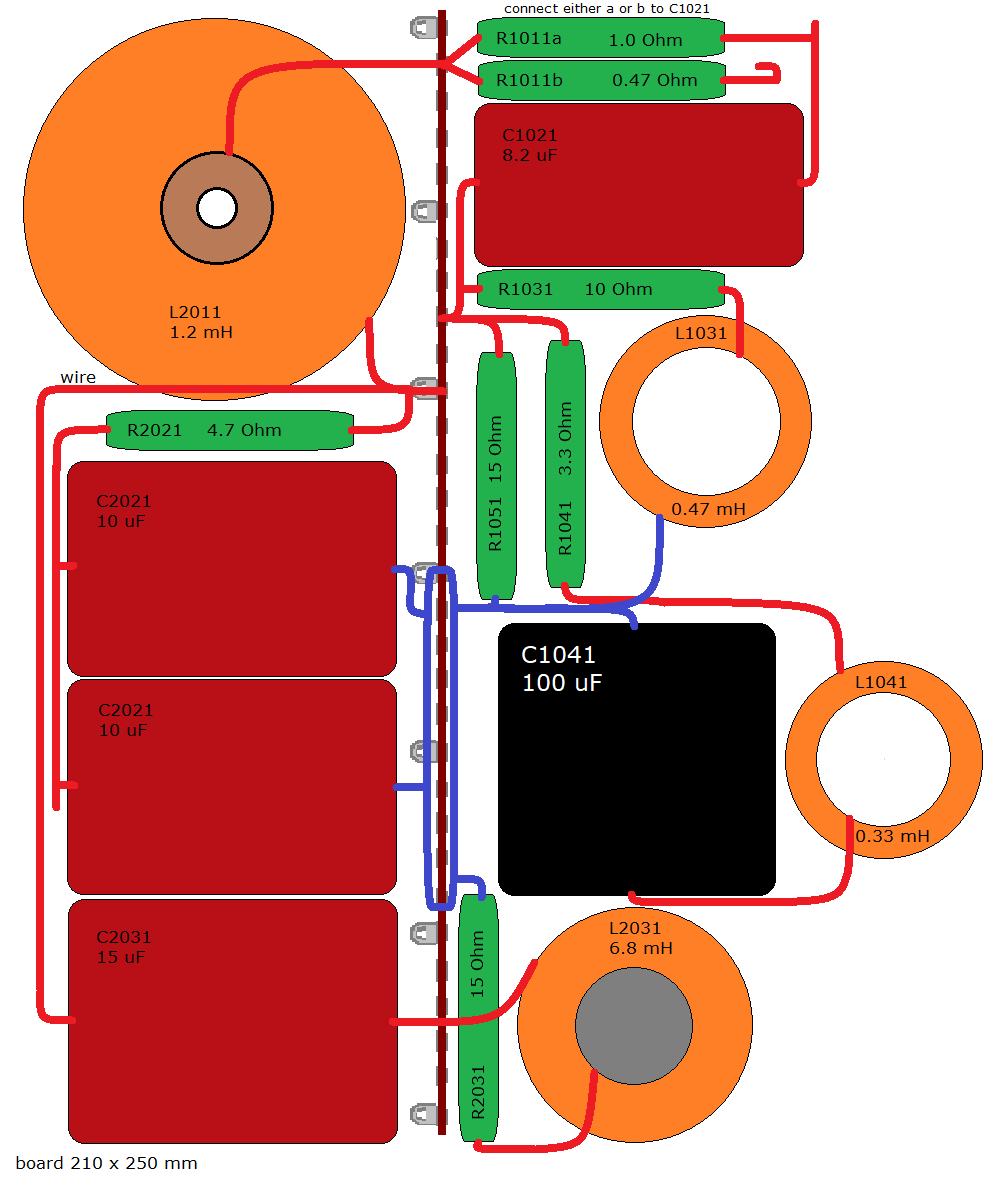
For the TQWT you only use the above.
R1011a: low treble level.
R1011b: high treble level.
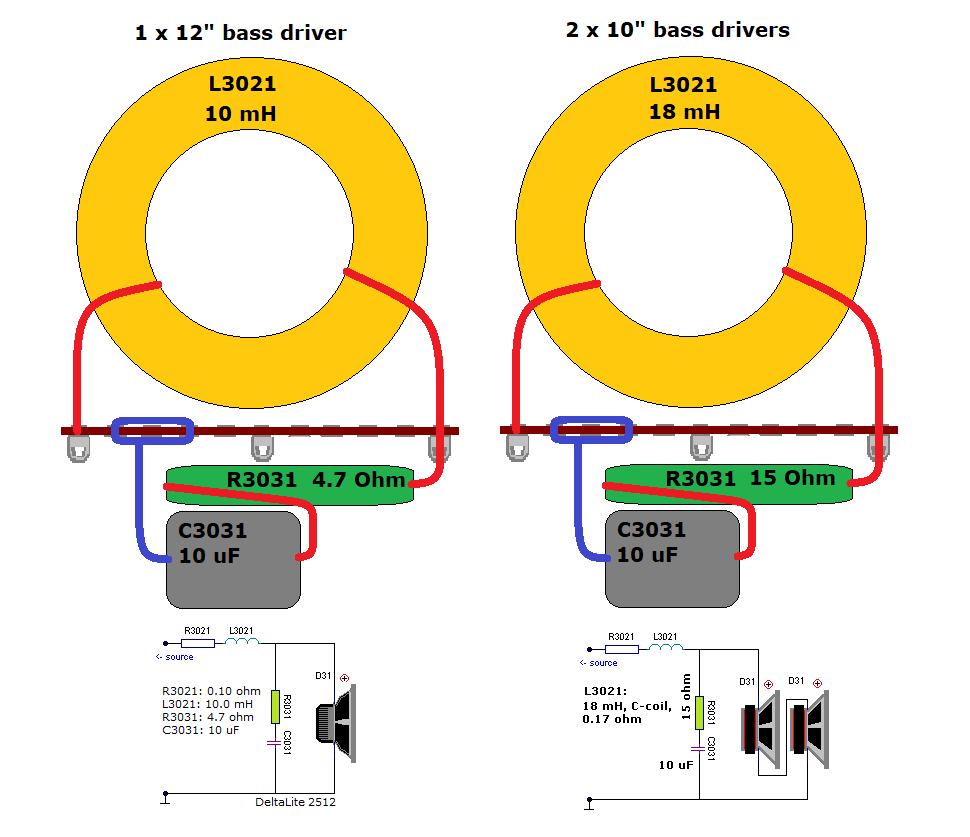
Crossover for bass in DTQWT
Speaker Wiring
Click image to view large
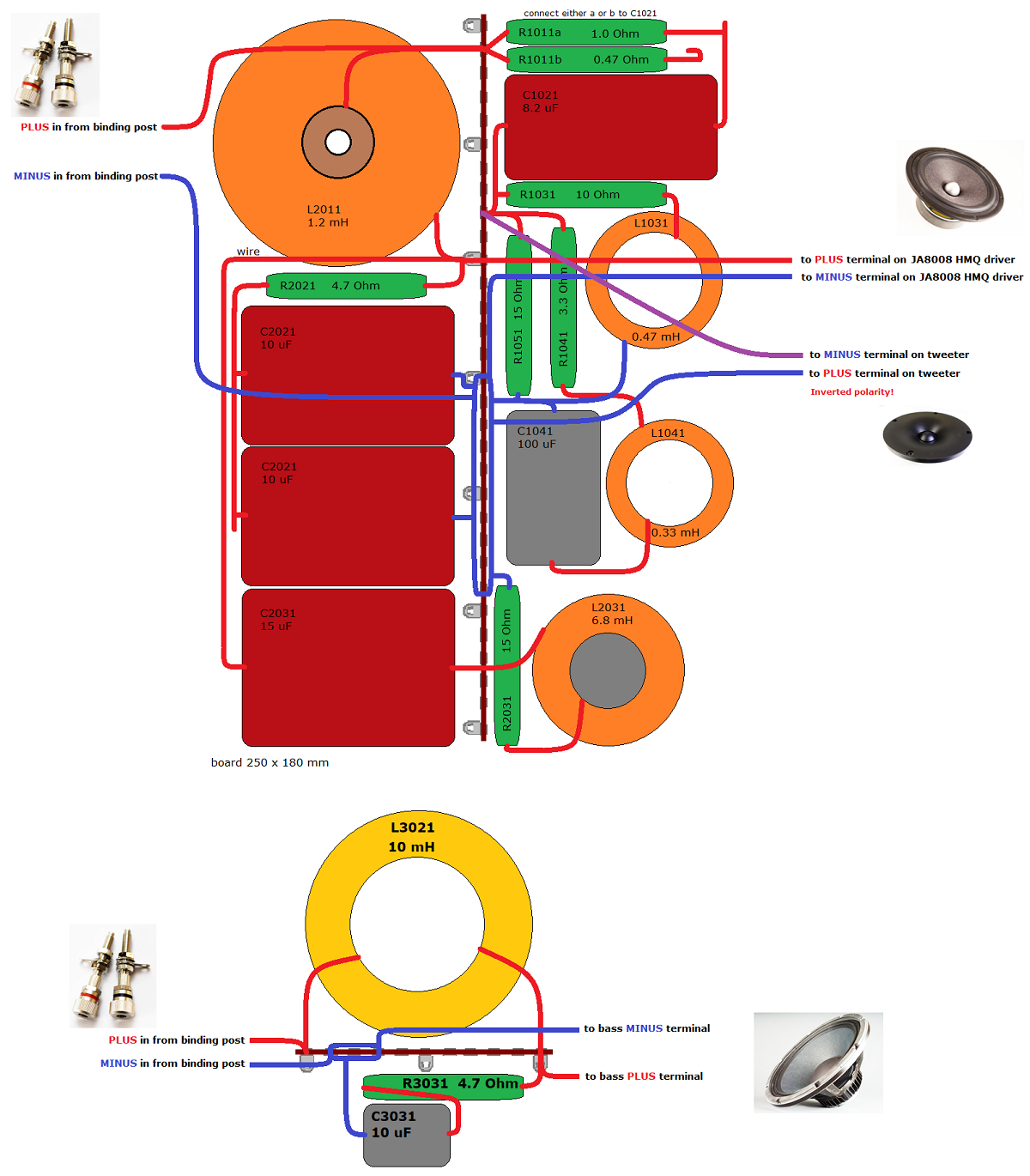
Click image above to view large.
Cabinet
TQWT mkIII
BACK TO INDEX
Cabinet damping is the same as for the DTQWT front chamber and top. No
damping in rear chamber.
Go to cabinet damping
Cabinet DTQWT
mkIII
BACK TO
INDEX
Click image to view large.
If you choose to do the 2 x 10" version
for the sake of higher impedance, you can obviously leave out the rear
fillets and do the rear panel like the mkII version:
http://www.troelsgravesen.dk/JA8008_DTQWT_cabs_files/DTQWT_cab_draw_v3.png
Also check out construction images from the mkII version here:
http://www.troelsgravesen.dk/JA8008_DTQWT_cabs.htm
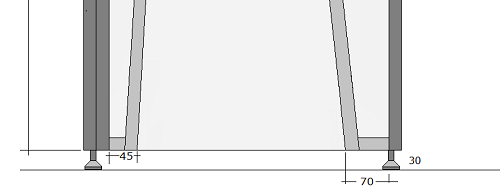
You can also make the bottom like this if cutting angles is tricky.
DTQWT mkIII CABINET CONSTRUCTION IMAGES
BACK TO INDEX
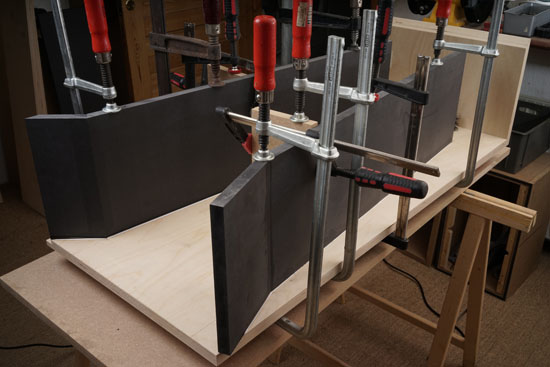
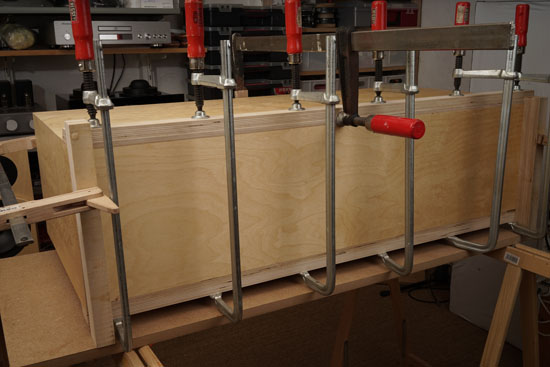
Left: Gluing inner baffles in place. For no particular reason I used 18
mm black MDF for inner panels. 18-20 mm panels of any kind will do.
Right: Gluing rear fillets.
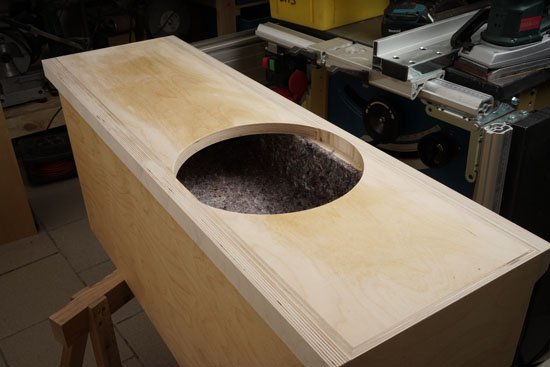
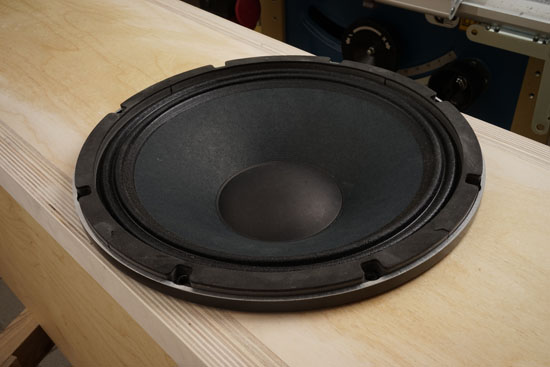
Left: Routing for the bass driver finished, 280 mm diameter. Right:
Testing bass driver.
Bass driver is not flush mounted. If you want to do so, increase rear
panel thickness by 15-18 mm and keep internal dimensions.
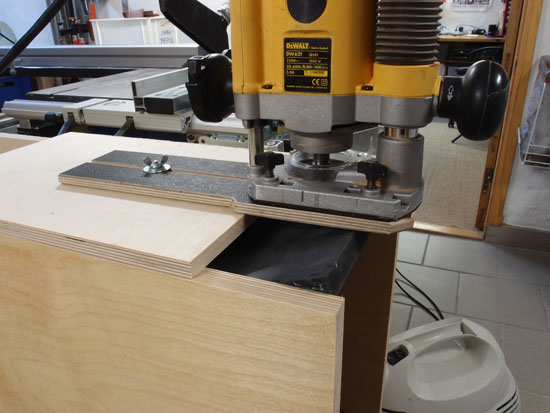
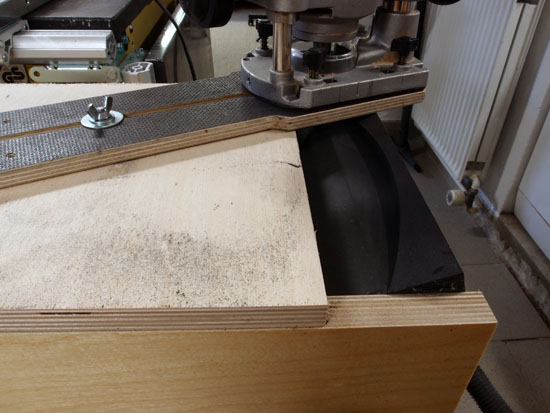
Routing the front inner panel towards floor. I had this question quite
a few times: How do you chamfer the inner front panel towards floor?
Hope the images are self explanatory.
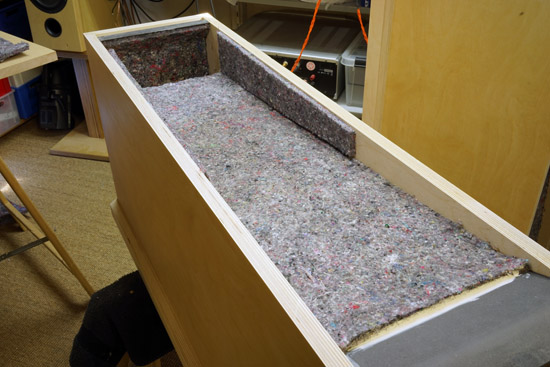
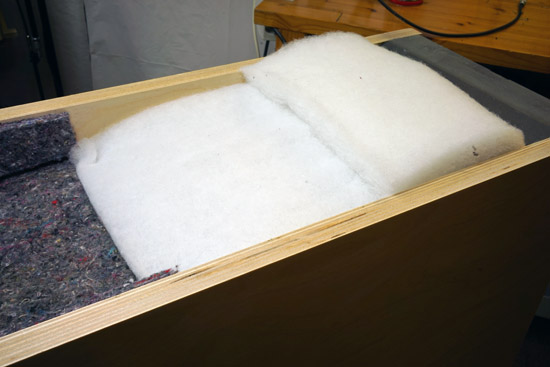
Cabinet damping of front horn.
Top and reflectors are added 8 mm felt material.
Front horn internal baffle is added felt in entire length and 50 cm
length on sides as seen on photo.
At bottom a piece of 50 x 24 mm 30 mm acoustilux is folded and attached
like seen on photo. I used staples.
View drawing at bottom for complete damping instruction.
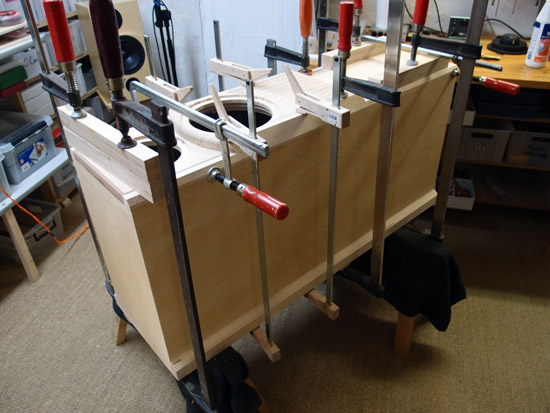
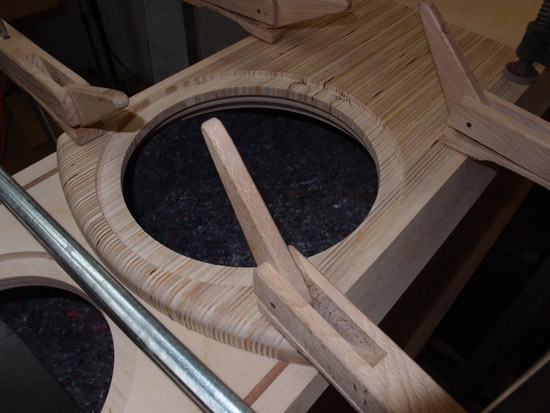
Gluing front panels.
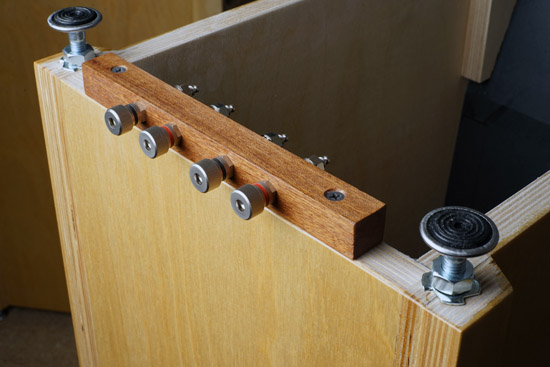
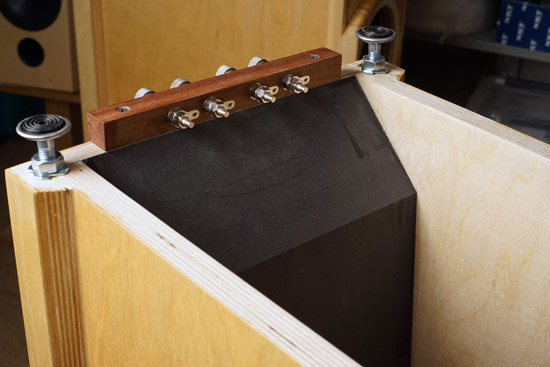
For the terminals I decided to place these on a mahogany bar on the
bottom to the rear. Makes wiring very easy and wires very short.
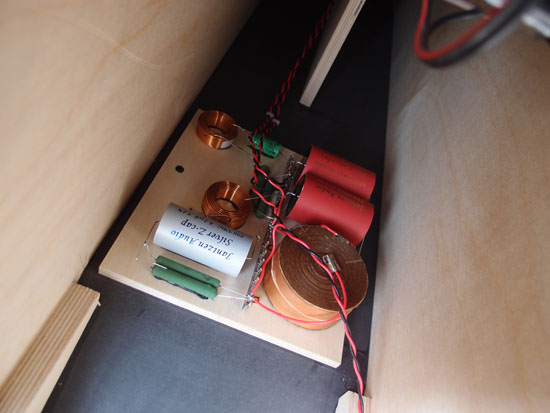
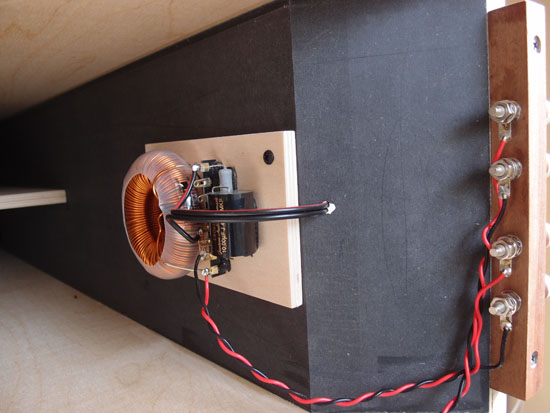
Crossovers sections placed on front and rear inner panels. Note easy
access to tweeter attenuation resistors.
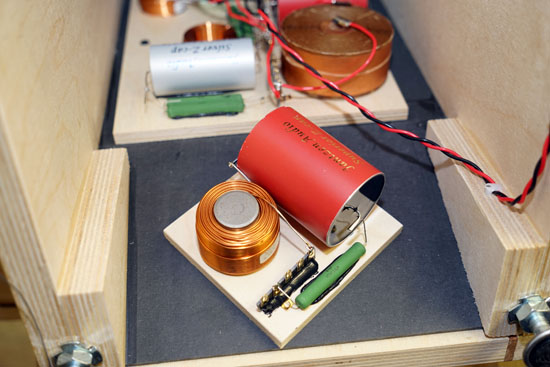
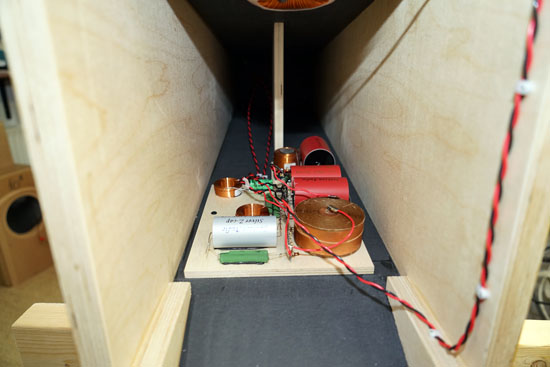
Midrange equaliser circuit on separate board as this was added later in
development.
Obviously this can be mounted on a single board together with the other
components.
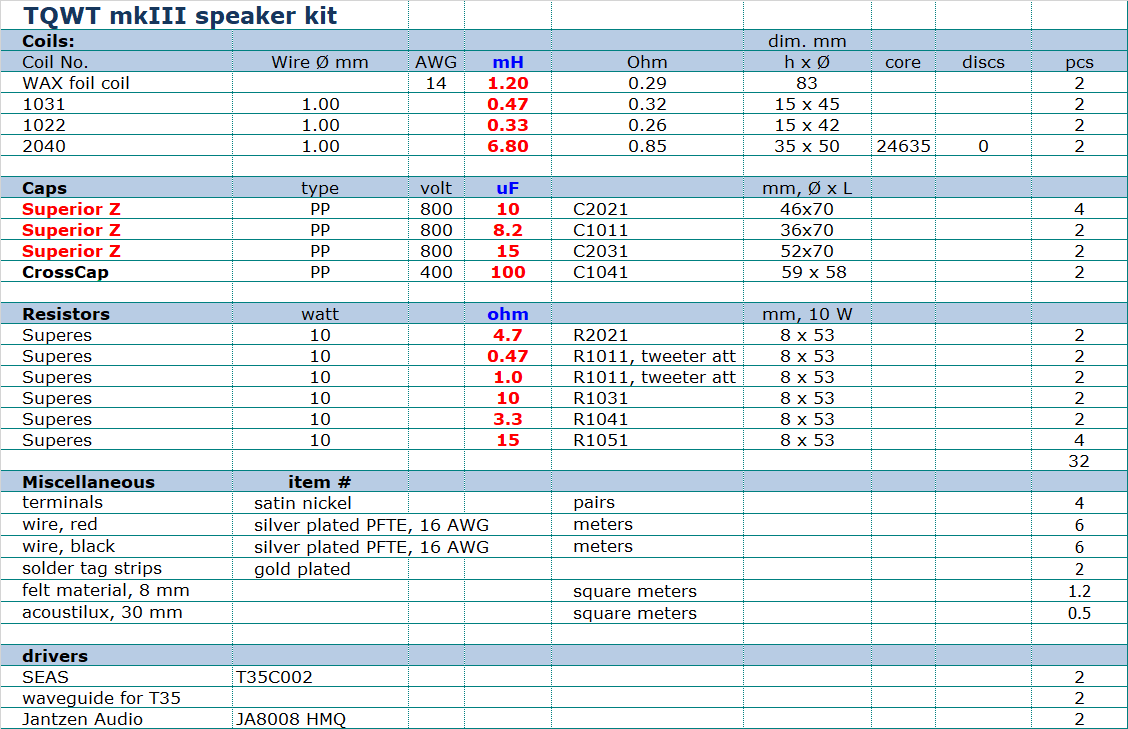
Complete kit only available from Jantzen Audio, contact@jantzen-audio.com
Please state where you live for full quotation incl. shipping.
All kit and component prices may be subject to change and are always to be confirmed by Jantzen Audio Denmark.
Download sales
presentations for four versions of TQWT

The Stand-Z versions still holds Superior-Z cap for the tweeter.
Sup-Z: All Superior-Z caps
Wax: Wax series coil for 8008 driver
T35: SEAS T35C002 tweeter
All technical questions to me at troels.gravesen@hotmail.com
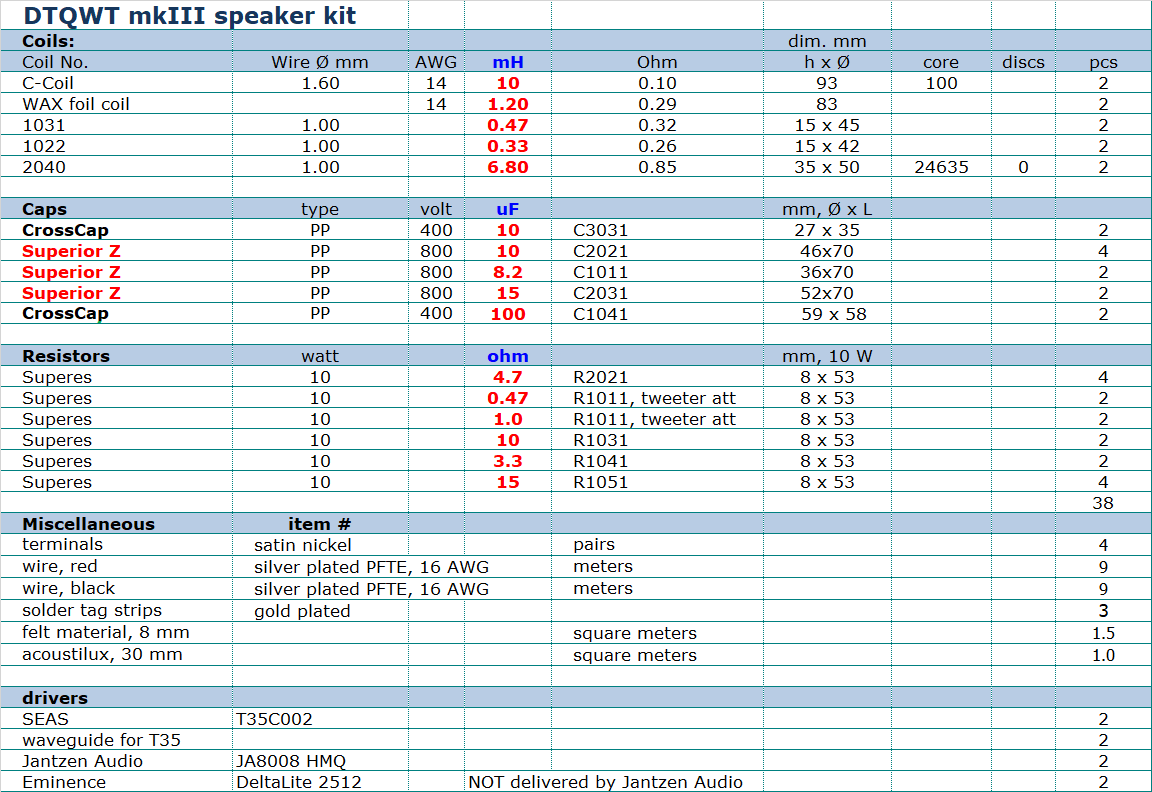
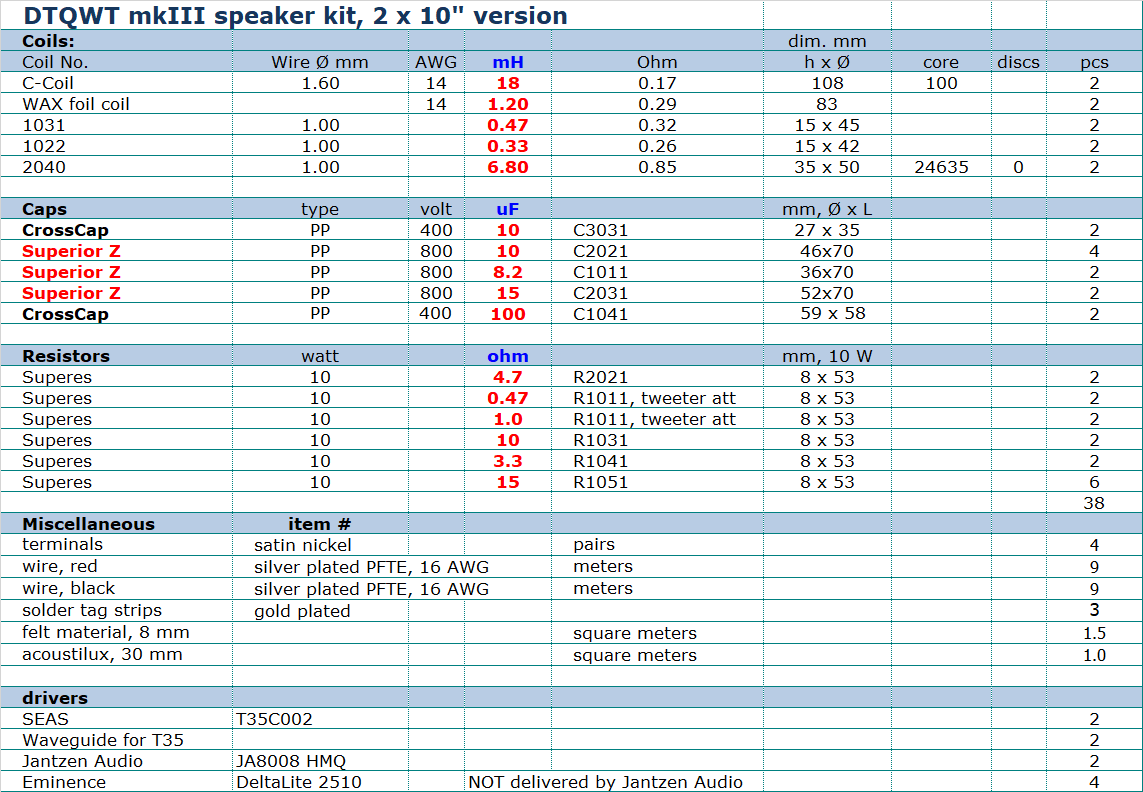
Complete kit only available from Jantzen Audio, contact@jantzen-audio.com
Please state where you live for full quotation incl. shipping.
All kit and component prices may be subject to change and are always to be confirmed by Jantzen Audio Denmark.
Download sales presentations for DTQWT mkIII with 1 x 12" or 2 x 10" bass drivers:
All technical questions to me at troels.gravesen@hotmail.com
A few comments on
MEASUREMENTS before you start interpreting all the
readings below.
First of all, if you think measurements will tell you how a speaker
sounds, you're wrong, very much wrong indeed. The perception of sound is
way too subjective to be reflected in any measurements we can perform. A
loudspeaker system is meant to give us a satisfying idea of an acoustic
event and for some people a pair of 5 USD ear-plugs are enough, others
spend 200 kUSD on a truly full-range pair of speakers - and the latter
may not be happier than the former.
Measurements may give us an idea of tonal balance of a system, i.e. too
much or too little energy in certain areas. Measurements may tell us
about bass extension if far-field measurements are merged with
near-field measurements. In addition to this, ports may contribute to
bass extension. Most of us diy'ers do not have access to an anechoic
room for full-range measurements from 20-20000 Hz.
What cannot be seen is what kind of bass performance we get in a given
room. Bass performance is highly dependent on in-room placement of your
speaker and the same speaker can be boomy in one place and lean in
another. Actual SPL level at 1 meter distance and 2.8V input is useful
for en estimate of system sensitivity and combined with the impedance
profile may give an idea of how powerful an amplifier is needed to drive
the speaker to adequate levels.
What measurements do not tell is the very sound of the speaker unless
displaying serious linear distortion. The level of transparency, the
ability to resolve micro-details, the "speed" of the bass, etc., cannot
be derived from these data. Distortion measurements rarely tell much
unless seriously bad, and most modern drivers display low distortion
within their specified operating range.
Many people put way too much into these graphs and my comments here are
only meant as warning against over-interpretation. There are more to
good sound than what can be extracted from a few graphs. Every graph
needs interpretation in terms of what it means sonically and how it
impacts our choice of mating drivers, cabinet and crossover design.
What measurements certainly do not tell is the sonic signature of the
drivers, because cones made from polyprop, alu, kevlar, paper, glass
fiber, carbon fiber, magnesium, ceramics or even diamonds all have their
way of colouring the sound.
Here are some DTQWT mkIII screen shots from the CLIO measuring system:
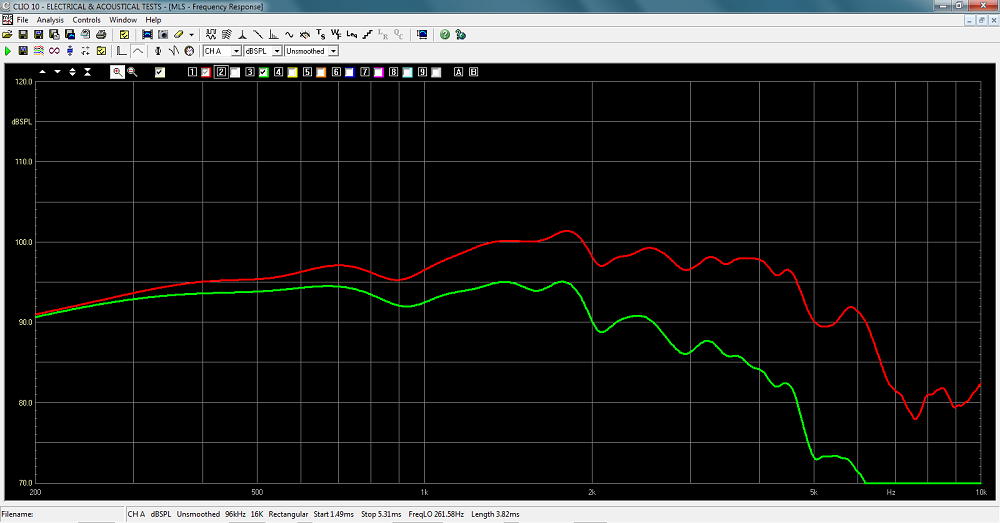
Above the basic response from the new 8008-HMQ driver in DTQWT cabinet. Red is without any filter, green with 1.0 mH in series with the driver.
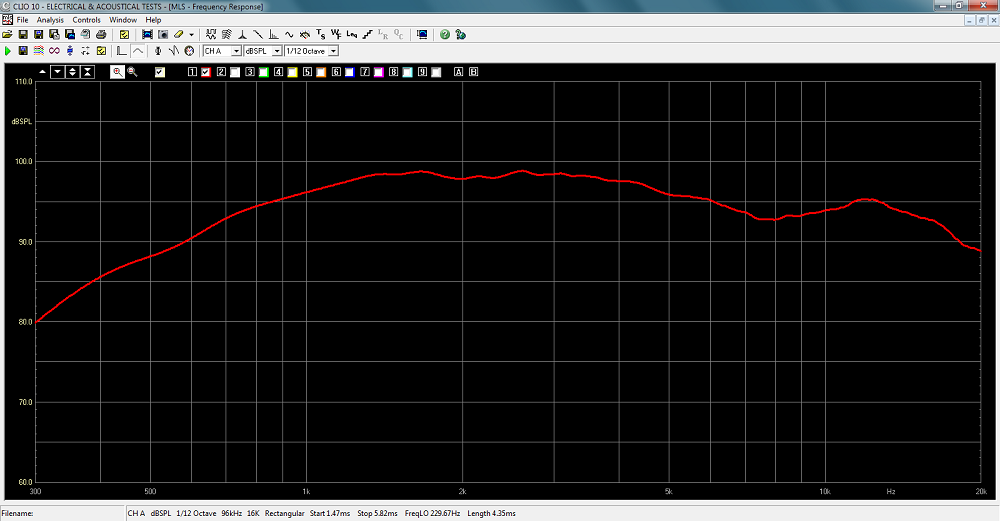
Above the T35 tweeter incl. waveguide mounted in DTQWT cabinet. The waveguide will boost the response in the 2-7 kHz range. Overall a response that makes crossover work easy.
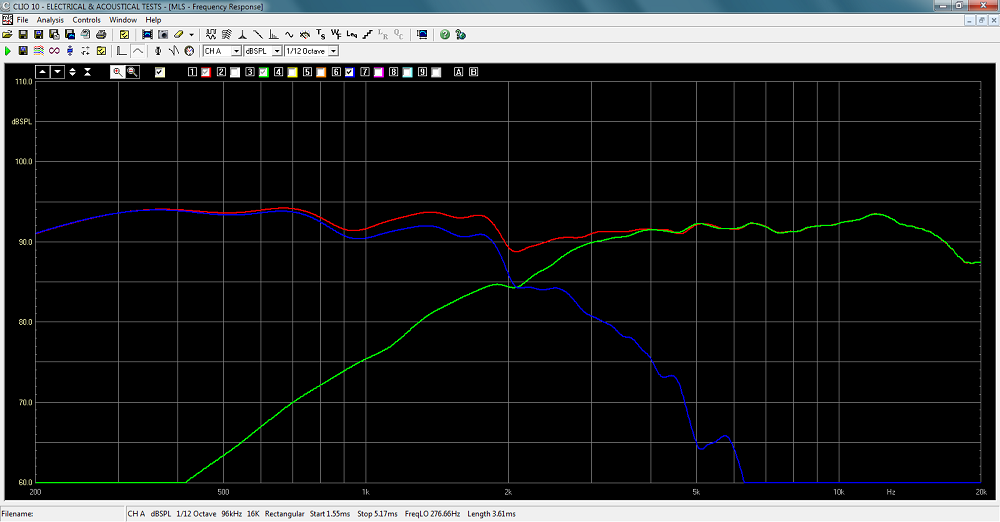
Above the two most important measurements. Left: SPL from drivers driven from crossover and summed response. System sensitivity around 94 dB/2.8V. Here the midrange counts. How we tune the treble level is a matter of taste and overall system set-up. With R1011 = 0 ohm we have a fairly flat response. I prefer 1 ohm in series with the tweeter making a better balance of basic notes and overtones. Point of crossover is around 2.1 kHz.
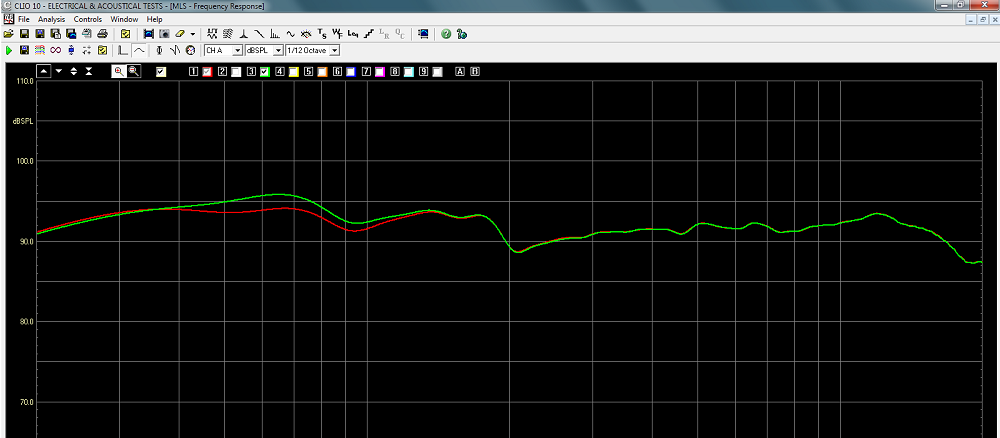
Above the impact of mid LCR equalising circuit. Initially I left out the circuit and enjoyed a slightly vintage presentation from the elevated 500-800 Hz range and it's easy to be seduced from a response that emphasize a particular frequency band a little. We tend to think it delivers more detail. However, after some months of listening I started fine-tuning the midband and removed the ~1.5 dB bump and this is what it should be. Slightly less presence but more depth and perspective. Try it out and decide for yourself. The crossover provides you two opportunities to modify the sound to your taste: Mid equalisation and treble level.
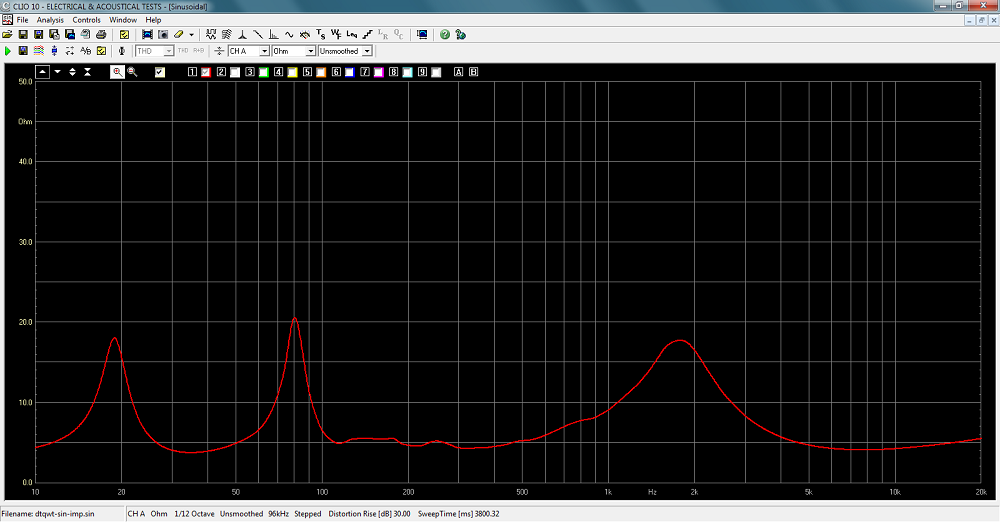
System impedance displaying 5 ohms in most of the range and a minimum of 3.8 ohm at 38 Hz. My KT88 PP amp has no trouble running this speaker. The minor ripples around 100-300 Hz are normal for a horn-loaded system, in fact this looks very good compared to the few who dare publish such data. The 12" Eminence here goes deeper than the mkII version and I was a bit surprised to hear that as the horn basically is the same length, but apparently the 2512 bass driver does a bit more in the low end. And by the way, this 12" takes some beating to loosen up before delivering. Stretch the suspensions by pulling and pushing the membrane to its extremes and don't stick your fingers through the membrane! This simple exercise is equivalent to hours of burn-in. For the 8008-HMQ and T35 I don't find any change in sound over time.
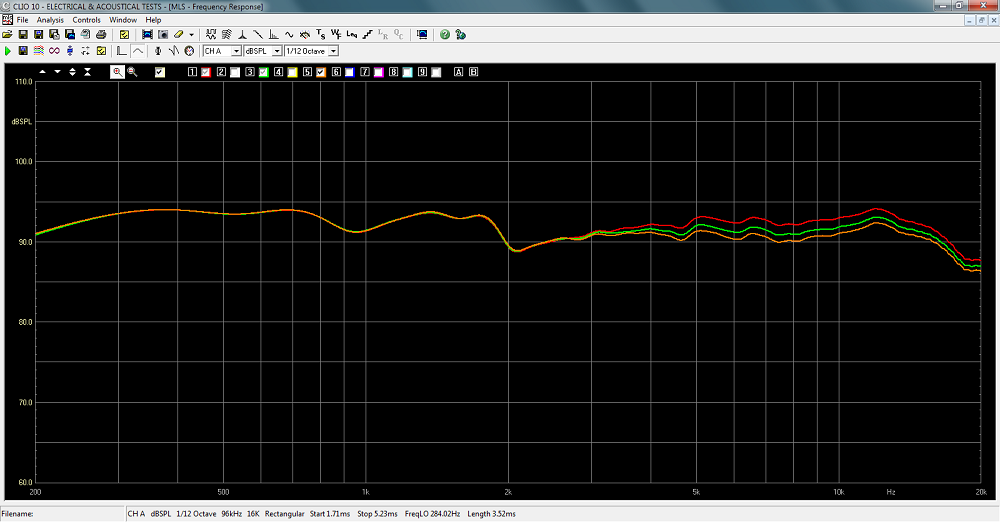
Treble level tuning. Red is R1011 = 0.47 Ohm, green = 1.0 Ohm and orange
= 1.5 Ohm.
Do not be
seduced by tizz and treble detail from the highest level.
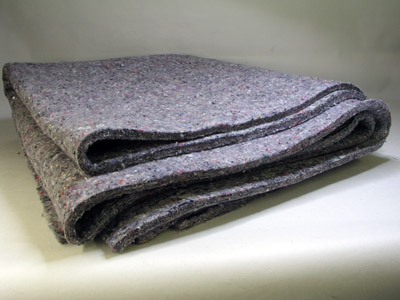
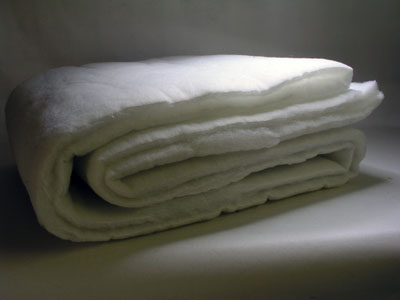
Cabinet damping follows the same rules as for the
original version of the DTQWT. Above what comes with the kit.
Only the top of the internal side panels are added 8 mm felt material.
Otherwise no damping materials in the center horn.
